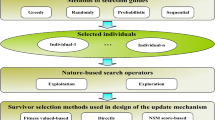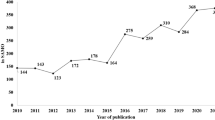Abstract
This paper presents the Multiscale Medalist Learning Algorithm (MMLA) as a novel heuristic approach for complex engineering optimization problems. By extending the Medalist Learning Algorithm, MMLA offers enhanced solution efficiency. The algorithm divides the learning process into successive periods with reduced search spaces, enabling focused search efforts in promising areas. Within each period, predefined learning stages are implemented. Top performers, known as medalists, engage in self-improvement operations through neighborhood searches, while common learners either learn from medalists or adapt based on the current state using neighborhood fluctuation. The MMLA balances exploration and exploitation capabilities through a natural growth curve that determines the learning efficiency. The MMLA's effectiveness and robustness are illustrated through the solution of a two-dimensional benchmark optimization problem and the successful resolution of ten well-known engineering design optimization problems. Comparative analysis demonstrates that the MMLA consistently outperforms other algorithms, providing competitive solutions with strict feasibility and minimal variation.







Similar content being viewed by others
Data availability
The data that support the findings of this study are available from the corresponding author upon request.
References
Wolpert, D.H., Macready, W.G.: No free lunch theorems for optimization. IEEE Trans. Evol. Comput. 1, 67–82 (1997)
He, S.-X.: Truss optimization with frequency constraints using the medalist learning algorithm. Structures 55, 1–15 (2023)
Holland, J.H.: Genetic algorithms. Sci. Am. 267, 66–73 (1992)
Kennedy, J., Eberhart, R.: Particle swarm optimization. In: Proceedings of ICNN'95 - International Conference on Neural Networks, pp. 1942–8, vol.4 (1995)
He, S., Prempain, E., Wu, Q.H.: An improved particle swarm optimizer for mechanical design optimization problems. Eng. Optim. 36, 585–605 (2004)
Storn, R., Price, K.: Differential evolution—a simple and efficient heuristic for global optimization over continuous spaces. J. Glob. Optim. 11, 341–359 (1997)
Mezura-Montes, E., Coello, C.A.C.: A simple multimembered evolution strategy to solve constrained optimization problems. IEEE Trans. Evol. Comput. 9, 1–17 (2005)
Karaboğa, D.: An idea based on honey bee swarm for numerical optimization (2005)
Dorigo, M., Birattari, M., Stutzle, T.: Ant colony optimization. IEEE Comput. Intell. Mag. 1, 28–39 (2006)
Eusuff, M., Lansey, K., Pasha, F.: Shuffled frog-leaping algorithm: a memetic meta-heuristic for discrete optimization. Eng. Optim. 38, 129–154 (2006)
Simon, D.: Biogeography-based optimization. IEEE Trans. Evol. Comput. 12, 702–713 (2008)
Yang, X.-S., Deb, S.: Cuckoo search via Lévy flights. In: 2009 World Congress on Nature & Biologically Inspired Computing (NaBIC): IEEE, pp. 210–4 (2009)
Oftadeh, R., Mahjoob, M.J., Shariatpanahi, M.: A novel meta-heuristic optimization algorithm inspired by group hunting of animals: Hunting search. Comput. Math. Appl. 60, 2087–2098 (2010)
Yang, X.-S.: A new metaheuristic bat-inspired algorithm. In: Nature inspired cooperative strategies for optimization (NICSO 2010). Springer, pp. 65–74 (2010)
Yang, X.S., Hossein, G.A.: Bat algorithm: a novel approach for global engineering optimization. Eng. Comput. 29, 464–483 (2012)
Yang, X.-S.: Firefly algorithm, stochastic test functions and design optimisation. arXiv preprint arXiv:100314092010, pp. 1–12
Yang, X.-S.: Flower pollination algorithm for global optimization. In: International Conference on Unconventional Computation and Natural Computation (2012)
Yang, X.-S., Karamanoglu, M., He, X.: Flower pollination algorithm: a novel approach for multiobjective optimization. Eng. Optim. 46, 1222–1237 (2014)
Mirjalili, S., Mirjalili, S.M., Lewis, A.: Grey wolf optimizer. Adv. Eng. Softw. 69, 46–61 (2014)
Mirjalili, S.: Moth-flame optimization algorithm: a novel nature-inspired heuristic paradigm. Knowl.-Based Syst. 89, 228–249 (2015)
Mirjalili, S., Lewis, A.: The whale optimization algorithm. Adv. Eng. Softw. 95, 51–67 (2016)
Mirjalili, S., Gandomi, A.H., Mirjalili, S.Z., Saremi, S., Faris, H., Mirjalili, S.M.: Salp swarm algorithm: a bio-inspired optimizer for engineering design problems. Adv. Eng. Softw. 114, 163–191 (2017)
Azizyan, G., Miarnaeimi, F., Rashki, M., Shabakhty, N.: Flying Squirrel Optimizer (FSO): a novel SI-based optimization algorithm for engineering problems. Iran. J. Optim. 11, 177–205 (2019)
Heidari, A.A., Mirjalili, S., Faris, H., Aljarah, I., Mafarja, M., Chen, H.: Harris hawks optimization: algorithm and applications. Futur. Gener. Comput. Syst. 97, 849–872 (2019)
Abdollahzadeh, B., Gharehchopogh, F.S., Mirjalili, S.: African vultures optimization algorithm: a new nature-inspired metaheuristic algorithm for global optimization problems. Comput. Ind. Eng. 158, 107408 (2021)
Zhao, W., Wang, L., Mirjalili, S.: Artificial hummingbird algorithm: a new bio-inspired optimizer with its engineering applications. Comput. Methods Appl. Mech. Eng. 388, 114194 (2022)
Ghosh, A., Deb, K., Goodman, E., Averill, R.: A user-guided innovization-based evolutionary algorithm framework for practical multi-objective optimization problems. Eng. Optim. 1–13 (2022)
Liu, Z., Wang, W., Shi, G., Zhu, P.: A modified crow search algorithm based on group strategy and adaptive mechanism. Eng. Optim. 1–19 (2023)
Li, J.-R., Li, H.-Y., Lim, M.K., Chiu, A.S.F., Tseng, M.-L.: Improved artificial jellyfish search algorithm: virtual synchronous generator control strategy. Eng. Optim. 1–20 (2023)
Ray, T., Liew, K.M.: Society and civilization: an optimization algorithm based on the simulation of social behavior. IEEE Trans. Evol. Comput. 7, 386–396 (2003)
Lee, K.S., Geem, Z.W.: A new meta-heuristic algorithm for continuous engineering optimization: harmony search theory and practice. Comput. Methods Appl. Mech. Eng. 194, 3902–3933 (2005)
Geem, Z.W.: Optimal cost design of water distribution networks using harmony search. Eng. Optim. 38, 259–277 (2006)
Rao, R.V., Savsani, V.J., Vakharia, D.P.: Teaching–learning-based optimization: a novel method for constrained mechanical design optimization problems. Comput. Aided Des. 43, 303–315 (2011)
Rao, R.V., Savsani, V.J., Balic, J.: Teaching–learning-based optimization algorithm for unconstrained and constrained real-parameter optimization problems. Eng. Optim. 44, 1447–1462 (2012)
Awad, R.: Sizing optimization of truss structures using the political optimizer (PO) algorithm. Structures 33, 4871–4894 (2021)
Kirkpatrick, S., D, G.C., P, V.M.: Simulated annealing. Science 220, 671–80 (1983)
Lim, K.C.W., Wong, L.-P., Chin, J.F.: Simulated-annealing-based hyper-heuristic for flexible job-shop scheduling. Eng. Optim. 1–17 (2022)
Formato, R.: Central force optimization: a new metaheuristic with applications in applied electromagnetics. Prog. Electromagn. Res. 77, 425–491 (2007)
Rashedi, E., Nezamabadi-pour, H., Saryazdi, S.G.S.A.: A gravitational search algorithm. Inf. Sci. 179, 2232–2248 (2009)
Kaveh, A., Talatahari, S.: A novel heuristic optimization method: charged system search. Acta Mech. 213, 267–289 (2010)
Eskandar, H., Sadollah, A., Bahreininejad, A., Hamdi, M.: Water cycle algorithm—a novel metaheuristic optimization method for solving constrained engineering optimization problems. Comput. Struct. 110–111, 151–166 (2012)
Moghaddam, F.F., Moghaddam, R.F., Cheriet, M.: Curved space optimization: a random search based on general relativity theory. arXiv preprint arXiv 2012;1:12082214
Hatamlou, A.: Black hole: a new heuristic optimization approach for data clustering. Inf. Sci. 222, 175–184 (2013)
Sadollah, A., Bahreininejad, A., Eskandar, H., Hamdi, M.: Mine blast algorithm: a new population based algorithm for solving constrained engineering optimization problems. Appl. Soft Comput. 13, 2592–2612 (2013)
Stochastic, S.H., Search, F.: A powerful metaheuristic algorithm. Knowl.-Based Syst. 75, 1–18 (2015)
Savsani, P., Savsani, V.: Passing vehicle search (PVS): a novel metaheuristic algorithm. Appl. Math. Model. 40, 3951–3978 (2016)
Kaveh, A., Dadras, A.: A novel meta-heuristic optimization algorithm: thermal exchange optimization. Adv. Eng. Softw. 110, 69–84 (2017)
Faramarzi, A., Heidarinejad, M., Stephens, B., Mirjalili, S.: Equilibrium optimizer: a novel optimization algorithm. Knowl.-Based Syst. 191, 105190 (2020)
Zhao, W., Wang, L., Zhang, Z.: Artificial ecosystem-based optimization: a novel nature-inspired meta-heuristic algorithm. Neural Comput. Appl. 32, 9383–9425 (2020)
Ma, H., Wei, H., Tian, Y., Cheng, R., Zhang, X.: A multi-stage evolutionary algorithm for multi-objective optimization with complex constraints. Inf. Sci. 560, 68–91 (2021)
Yildiz, B.S., Pholdee, N., Bureerat, S., Yildiz, A.R., Sait, S.M.: Enhanced grasshopper optimization algorithm using elite opposition-based learning for solving real-world engineering problems. Eng. Comput. 38, 4207–4219 (2022)
Zhang, Y.: Elite archives-driven particle swarm optimization for large scale numerical optimization and its engineering applications. Swarm Evol. Comput. 76, 101212 (2023)
Jamil, M., Yang, X.-S.: A literature survey of benchmark functions for global optimisation problems. Int. J. Math. Model. Numer. Optim. 4, 150–194 (2013)
Author information
Authors and Affiliations
Corresponding author
Ethics declarations
Conflict of interest
No potential conflict of interest was reported by the authors.
Additional information
Publisher's Note
Springer Nature remains neutral with regard to jurisdictional claims in published maps and institutional affiliations.
Appendix A. Constrained benchmark mechanical and engineering design problems
Appendix A. Constrained benchmark mechanical and engineering design problems
1.1 Multiple-disk clutch brake design
Consider variable \(x=\left({r}_{i},{r}_{o},t,F,Z\right)\)
Minimize \(f\left(x\right)=\pi \left({r}_{o}^{2}-{r}_{i}^{2}\right)t\left(Z+1\right)\rho \)
Subject to:
where \({M}_{h}=\frac{2}{3}\mu FZ\frac{{r}_{o}^{3}-{r}_{i}^{3}}{{r}_{o}^{2}-{r}_{i}^{2}}, {p}_{rz}=\frac{F}{\pi ({r}_{o}^{2}-{r}_{i}^{2})}, {M}_{h}=\frac{{2\pi n(r}_{o}^{3}-{r}_{i}^{3})}{90({r}_{o}^{2}-{r}_{i}^{2})}, T=\frac{{I}_{z}\pi n}{30({M}_{h}+{M}_{f})},\) \(\Delta r=20\,\mathrm{mm}\), \({t}_{\mathrm{max}}\)= 3 mm, \({t}_{\mathrm{min}}\)= 1.5 mm, \({l}_{\mathrm{max}}=30\,\mathrm{mm}\),\( {Z}_{\mathrm{max}}\)= 10,\({v}_{\mathrm{srmax}}\)= 10 m/s, \(\upmu =0.5\), \(\mathrm{s}=1.5, {M}_{s}\)= 40 Nm\(, {M}_{f}\)= 3 Nm\(, \mathrm{n}\)= 250 rpm\(, {p}_{\mathrm{max}}\)= 1 MPa\(, {I}_{z}\)= 55 \(\mathrm{kg }{\mathrm{mm}}^{2}, {T}_{\mathrm{max}}\)= 15 s\(, {F}_{\mathrm{max}}\)= 1000 N, \({r}_{\mathrm{min}}\)= 55 mm\(, {r}_{o \mathrm{max}}\)= 110 mm\(,\uprho =7800\,\mathrm{kg}/{m}^{3}\).
Variable range \({r}_{i}\in \left\{60, 61, 62,\dots , 80\right\}{, r}_{o}\in \left\{90, 91, 92,\dots , 110\right\}, t\in \left\{1.0, 1.5, 2.0, 2.5, 3\right\}, F\in \left\{600, 610, 620, \dots , 1000\right\}, Z\in \left\{\mathrm{2,3},\mathrm{4,5},\mathrm{6,7},\mathrm{8,9}\right\}\).
1.2 Rolling element bearing
Maximize \({C}_{d}={f}_{c}{Z}^{2/3}{D}_{b}^{1.8}\) if \({D}_{b}\le 25.4\) mm.
\({C}_{d}=3.64{f}_{c}{Z}^{2/3}{D}_{b}^{1.4}\) if \({D}_{b}>25.4\) mm.
Subject to:
where
1.3 Hydrodynamic thrust bearing
Minimize \(f(x)=\frac{Q{P}_{0}}{0.7}+{E}_{f}\)
Subject to: \({\mathrm{g}}_{1}\left(x\right)=W-{W}_{s}\ge 0,{\text{g}}_{2}\left(x\right)={P}_{\mathrm{max}}-{P}_{0}\ge 0, {\text{g}}_{3}\left(x\right)=\Delta {T}_{\mathrm{max}}-\Delta T\ge 0, {\text{g}}_{4}\left(x\right)=h-{h}_{\mathrm{min}}\ge 0\), \({\text{g}}_{5}\left(x\right)=R-{R}_{0}\ge 0\), \({\text{g}}_{6}\left(x\right)=\text{0.001-}\frac{\gamma }{g{P}_{0}}{\left(\frac{Q}{2\pi Rh}\right)}^{2}\ge 0\), \({\mathrm{g}}_{7}\left(x\right)=5000-\frac{W}{\pi \left({R}^{2}-{R}_{0}^{2}\right)}\ge 0\),
Where \(\upgamma =0.0307, \)C = 0.5, n = − 3.55\(, {C}_{1}\) = 10.04\(, {W}_{s}\) = 101,000\(, {P}_{\mathrm{max}}\) = 1000, \(\Delta {T}_{\mathrm{max}}\) = 50\(, {h}_{min}\) = 0.001, \(\mathrm{g}=386.4, \)N = 750\(, 1\le \mathrm{R},{R}_{0},Q\le 16, 1\mathrm{e}-6\le\upmu \le 16\mathrm{e}-6\).
1.4 Belleville spring
Minimize \(f\left(x\right)=0.07075\pi \left({D}_{e}^{2}-{D}_{i}^{2}\right)t\)
Subject to:
\({\text{g}}_{6}\left(x\right)={D}_{e}-{D}_{i}\ge 0, {\text{g}}_{7}\left(x\right)=0.3-\frac{1}{{D}_{e}-{D}_{i}}\ge 0,\) where \(\mathrm{\alpha }=\frac{6}{\pi \mathrm{ln}K}{\left(\frac{K-1}{K}\right)}^{2}, \beta =\frac{6}{\pi \mathrm{ln}K}\left(\frac{K-1}{\mathrm{ln}K}-1\right),\upgamma =\frac{6}{\pi \mathrm{ln}K}\left(\frac{K-1}{2}\right)\), \({P}_{max}=5400\,\text{lb, }{\delta }_{\mathrm{max}}=0.2\,{\text{in}}., S\) = 200 kPsi, E = 30 e6psi, \(\mu =0.3\), H = \(0.2\,{\text{in}}.\), \({D}_{\mathrm{max}}\) = 12.01 in., \(\mathrm{K}=\frac{{D}_{e}}{{D}_{i}}, {\delta }_{l}\) = \(f\left(a\right)h, a=h/t\). \(0.01\le t\le 6.0, 0.05\le h\le 0.5, 5.0\le {D}_{i},{D}_{e}\le 15.0\).
Values of \(\mathrm{f}(\mathrm{a})\) vary as shown in Table
13.
1.5 Step-cone pulley
Minimize \(f\left(x\right)=\rho w\left\{{d}_{1}^{2}\left[1+{\left(\frac{{N}_{1}}{N}\right)}^{2}\right]+{d}_{2}^{2}\left[1+{\left(\frac{{N}_{2}}{N}\right)}^{2}\right]+{d}_{3}^{2}\left[1+{\left(\frac{{N}_{3}}{N}\right)}^{2}\right]+{d}_{4}^{2}\left[1+{\left(\frac{{N}_{4}}{N}\right)}^{2}\right]\right\}\)
Subject to:
where \({C}_{i}\) indicates the length of the belt to obtain speed \({N}_{i}\) and is given by.
\({R}_{i}\) Is the tension ratio and is given by.
1.6 Speed reducer design
Minimize \(f\left(x\right)=0.7854{x}_{1}{x}_{2}^{2}\left(3.3333{x}_{3}^{2}+14.9334{x}_{3}-43.0934\right)-1.508{x}_{1}\left({x}_{6}^{2}+{x}_{7}^{2}\right) +7.4777\left({x}_{6}^{3}+{x}_{7}^{3}\right)+0.7854\left({x}_{4}{x}_{6}^{2}+{x}_{5}{x}_{7}^{2}\right)\)
Subject to:
where \(2.6\le {x}_{1}\le 3.6; 0.7\le {x}_{2}\le 0.8; \) \(17\le {x}_{3}\le 28;\) \(7.3\le {x}_{4}\le 8.3; 7.8\le {x}_{5}\le 8.3\); \(2.9\le {x}_{6}\le 3.9\); \(5.0\le {x}_{7}\le 5.5\).
1.7 Cantilever beam design
Minimize \(\mathrm{f}\left(\mathrm{x}\right)=0.0624\sum_{i=1}^{5}{x}_{i}\)
Subject to: \({\mathrm{g}}_{1}\left(x\right)=\frac{61}{{x}_{1}^{3}}+\frac{37}{{x}_{2}^{3}}+\frac{19}{{x}_{3}^{3}}+\frac{7}{{x}_{4}^{3}}+\frac{1}{{x}_{5}^{3}}-1\le 0\),
Variable range \(0.01\le {x}_{i}\le 100,i=\mathrm{1,2},\mathrm{3,4},5.\)
1.8 Three-bar truss design
Minimize \(\mathrm{f}\left(\mathrm{x}\right)=\left(2\sqrt{2}{x}_{1}+{x}_{2}\right)l\)
Subject to:
where \(l\) = 10 cm, \(P=2\) KN/\({\text{cm}}^{2},\sigma =2\) KN/\({\text{cm}}^{2}\), variable range \(0\le {x}_{1},{x}_{2}\le 1\).
1.9 Welded beam design
Consider \(x=\left({x}_{1},{x}_{2},{x}_{3},{x}_{4}\right)=\left(w,l,d,h\right)\),
minimize \(f\left(x\right)=1.10471{w}^{2}l+0.04811dh(14.0+l)\),
subject to.
where
With the variable range.
1.10 The pressure vessel design
Consider \(x=\left({x}_{1},{x}_{2},{x}_{3},{x}_{4}\right)=\left({T}_{s},{T}_{h},R,L\right)\),
Minimize \(f\left(x\right)=0.6224{x}_{1}{x}_{3}{x}_{4}+1.7781{x}_{2}{x}_{3}^{2}+3.1661{x}_{1}^{2}{x}_{4}+19.84{x}_{1}^{2}{x}_{3}\),
Subject to \({g}_{1}\left(x\right)=-{x}_{1}+0.0193{x}_{3}\le 0\)
Rights and permissions
Springer Nature or its licensor (e.g. a society or other partner) holds exclusive rights to this article under a publishing agreement with the author(s) or other rightsholder(s); author self-archiving of the accepted manuscript version of this article is solely governed by the terms of such publishing agreement and applicable law.
About this article
Cite this article
He, SX., Cui, YT. Multiscale medalist learning algorithm and its application in engineering. Acta Mech 235, 751–777 (2024). https://doi.org/10.1007/s00707-023-03773-2
Received:
Accepted:
Published:
Issue Date:
DOI: https://doi.org/10.1007/s00707-023-03773-2




